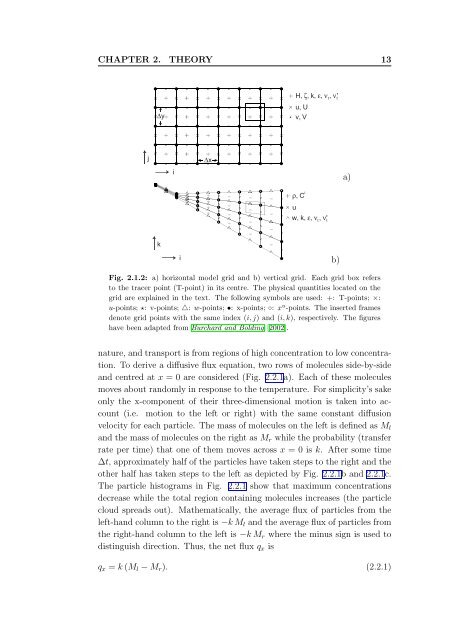Three-dimensional Lagrangian Tracer Modelling in Wadden Sea ...
Three-dimensional Lagrangian Tracer Modelling in Wadden Sea ...
Three-dimensional Lagrangian Tracer Modelling in Wadden Sea ...
Create successful ePaper yourself
Turn your PDF publications into a flip-book with our unique Google optimized e-Paper software.
CHAPTER 2. THEORY 13<br />
j<br />
∆y<br />
k<br />
i<br />
i<br />
∆x<br />
H, ζ, k, ε, ν , ν'<br />
u, U<br />
v, V<br />
ρ, C i<br />
u<br />
w, k, ε, ν , ν'<br />
t t<br />
Fig. 2.1.2: a) horizontal model grid and b) vertical grid. Each grid box refers<br />
to the tracer po<strong>in</strong>t (T-po<strong>in</strong>t) <strong>in</strong> its centre. The physical quantities located on the<br />
grid are expla<strong>in</strong>ed <strong>in</strong> the text. The follow<strong>in</strong>g symbols are used: +: T-po<strong>in</strong>ts; ×:<br />
u-po<strong>in</strong>ts; ⋆: v-po<strong>in</strong>ts; △: w-po<strong>in</strong>ts; •: x-po<strong>in</strong>ts; ◦: x u -po<strong>in</strong>ts. The <strong>in</strong>serted frames<br />
denote grid po<strong>in</strong>ts with the same <strong>in</strong>dex (i, j) and (i, k), respectively. The figures<br />
have been adapted from Burchard and Bold<strong>in</strong>g [2002].<br />
nature, and transport is from regions of high concentration to low concentration.<br />
To derive a diffusive flux equation, two rows of molecules side-by-side<br />
and centred at x = 0 are considered (Fig. 2.2.1a). Each of these molecules<br />
moves about randomly <strong>in</strong> response to the temperature. For simplicity’s sake<br />
only the x-component of their three-<strong>dimensional</strong> motion is taken <strong>in</strong>to account<br />
(i.e. motion to the left or right) with the same constant diffusion<br />
velocity for each particle. The mass of molecules on the left is def<strong>in</strong>ed as Ml<br />
and the mass of molecules on the right as Mr while the probability (transfer<br />
rate per time) that one of them moves across x = 0 is k. After some time<br />
∆t, approximately half of the particles have taken steps to the right and the<br />
other half has taken steps to the left as depicted by Fig. 2.2.1b and 2.2.1c.<br />
The particle histograms <strong>in</strong> Fig. 2.2.1 show that maximum concentrations<br />
decrease while the total region conta<strong>in</strong><strong>in</strong>g molecules <strong>in</strong>creases (the particle<br />
cloud spreads out). Mathematically, the average flux of particles from the<br />
left-hand column to the right is −k Ml and the average flux of particles from<br />
the right-hand column to the left is −k Mr where the m<strong>in</strong>us sign is used to<br />
dist<strong>in</strong>guish direction. Thus, the net flux qx is<br />
qx = k (Ml − Mr). (2.2.1)<br />
t<br />
t<br />
b)<br />
a)

















